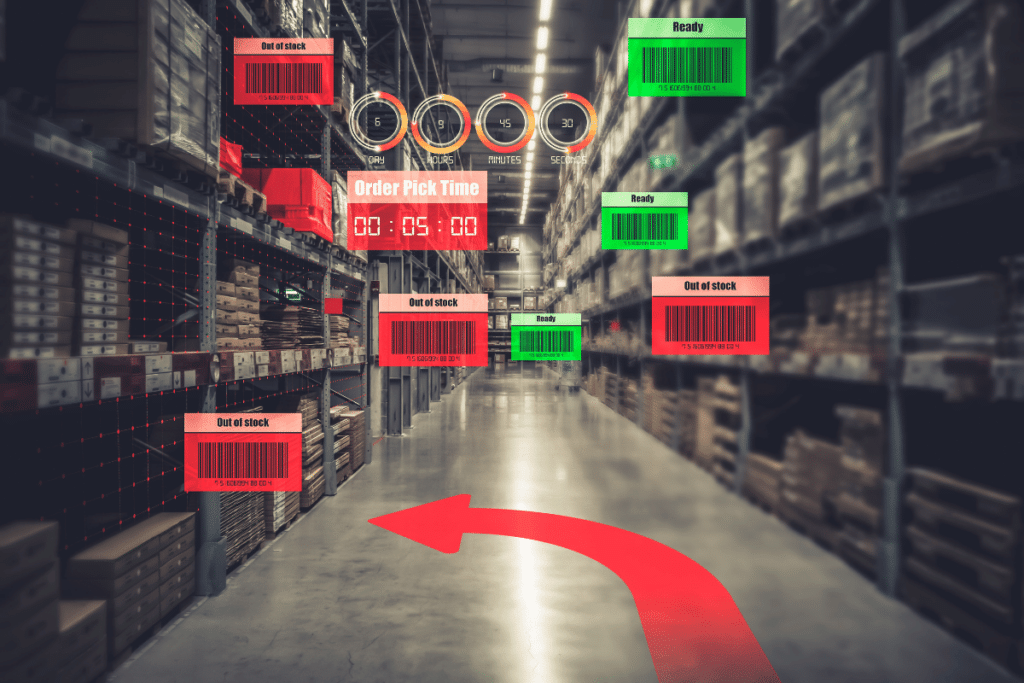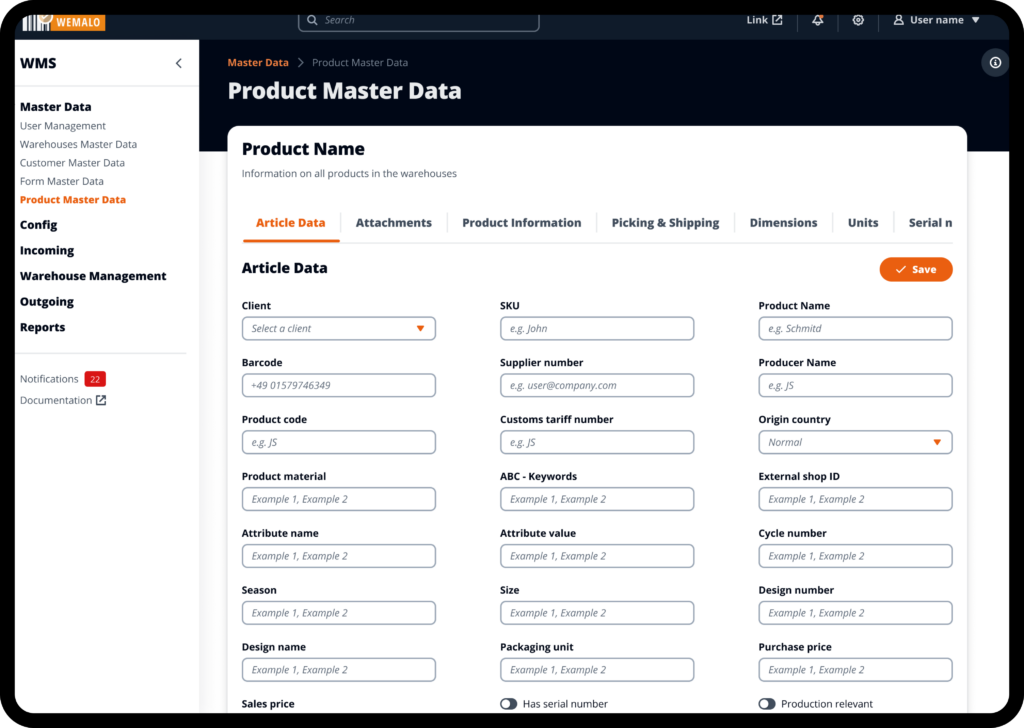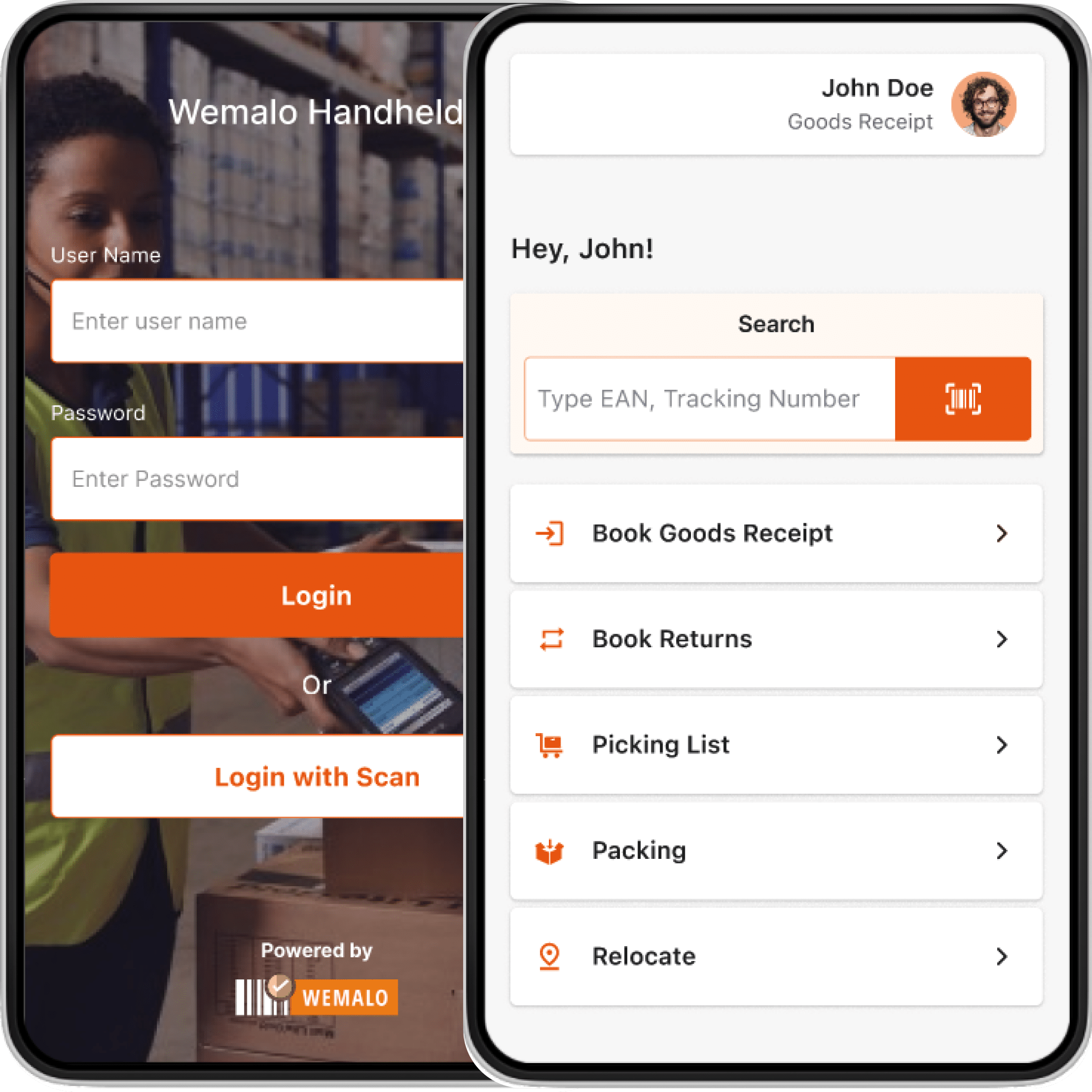Stock management software for small businesses: Optimise your warehouse management with efficient solutions
With features such as inventory management and mobile access to your system or as an app download, products and items are easy to manage.
Warehouse management made easy: efficient solutions for small businesses to optimise their warehouse processes. Stock management software

The topics to help you quickly get started on the site:
Advantages of warehouse management software for small businesses
Inventory management software offers small businesses a number of advantages over manual inventory management. Below, we will take a closer look at these advantages:
10 advantages that the use of warehouse management software offers companies:
- Accuracy of stock levels: Warehouse management software ensures accurate recording and updating of stock levels in real time, resulting in improved inventory control.
- Error reduction: Using warehouse management software can minimise manual errors when recording stock movements, resulting in higher data integrity.
- Optimisation of space requirements:Die Software ermöglicht eine effiziente Nutzung des LagerplatzeThe software enables efficient use of storage space by accurately recording inventory data and suggesting the optimal storage location allocation.
- Improved order processing: Stock management software enables faster and error-free order processing by synchronising stock data with order information, ensuring a smooth workflow.
- Reduction in operating costs: Through the efficient use of resources, reduction in stock levels and avoidance of excess stock, warehouse management software contributes to cost reduction.
- Time savings: Automated processes and workflows enable faster processing of stock movements, reducing overall operating time and increasing efficiency.
- Better delivery times: By optimising warehouse processes and providing quick access to inventory data, warehouse management software can enable improved delivery times to customers.
- Product traceability: The software enables complete traceability of products from entry to exit, which supports quality assurance and product liability.
- Real-time analysis and reporting: Warehouse management software offers the ability to generate real-time reports and analyses on inventory levels, productivity and performance to make informed operational decisions.
- Scalability and flexibility: Good warehouse management software grows with the business and adapts to changing requirements, allowing small businesses to seamlessly expand their warehouse management as the business grows.
Free and without obligation!

Efficient processes thanks to automated warehouse management
Warehouse management software automates many of the time-consuming tasks involved in manual warehouse management. It enables seamless integration of orders, tracking of goods receipt, storage, picking and shipping processes.
By automating these processes, small businesses can save time and resources and make their warehouse processes more efficient. Warehouse management software is an extremely useful solution for businesses looking to optimise their warehouse processes.
Overall, such a solution offers numerous advantages for small businesses in terms of efficiency and cost savings in logistics processes at their location and beyond!
Time and cost savings in inventory tracking
Effective inventory tracking is extremely important and a crucial component of successful warehouse management.
Warehouse management software provides real-time updates on current stock levels, enables products to be located quickly and facilitates stocktaking.
This enables small businesses to save time and money by reducing the effort required for manual inventory counts and avoiding bottlenecks or excess stock.


Optimisation of storage space utilisation for maximum efficiency
Warehouse management software enables optimal use of available storage space. It helps identify storage areas, indicates the ideal storage location for specific products, and enables optimal placement.
By making better use of storage space, small businesses can streamline their processes and reduce their storage costs. But optimal use of storage space is not the only advantage of such software. It also provides a better overview of current stock levels and enables faster and more accurate inventory management.
By scanning barcodes or QR codes, products can be easily recorded without errors. In addition, the warehouse management software also enables automatic reordering when certain products are low in stock.
This ensures that there is always sufficient stock and prevents bottlenecks. Another advantage is that data on goods movements in the warehouse can be accessed and evaluated in real time.
This allows you to recognise trends or identify weaknesses in the process, for example – valuable information for future decisions.
In short: good warehouse management software helps small businesses improve their processes, save costs and thus be more successful in the long term!
Choosing warehouse management software: What you should look out for
Choosing the right warehouse management software is crucial to the success of a small business. Here are some important aspects to consider when selecting warehouse management software:
Determining needs and analysing requirements
Before choosing warehouse management software, it is important to carefully analyse your company’s needs and requirements. Ensure that the software you choose offers the specific functions and tools you need to manage your warehouse processes efficiently.
Conduct a thorough needs analysis and identify the core functions. Another important consideration when selecting warehouse management software is integration with other systems and applications in your organisation.
Ensure that the software can be seamlessly integrated with your existing ERP or WMS solutions. In addition, you should also consider the support and service provided by the software provider.

Ensure that the company offers reliable customer service and can respond quickly in the event of any issues.
Another aspect is the user-friendliness of the software. An intuitive user interface not only makes your work as a user easier, but also reduces training costs for new employees.
Finally, you should consider whether a cloud-based solution could be useful in order to respond more flexibly to changes in the market.
Overall, it is worth investing time in a thorough analysis of your specific requirements and comparative research to select a suitable system – because this saves costs in the long term through more efficient processes!
10 aspects for choosing the right warehouse management software
- Business requirements analysis: Analyse your organisation’s specific requirements in terms of warehouse management to determine which features and tools you need.
- Scalability: Ensure that the warehouse management software is scalable and can grow with your business.
- Integration with existing systems: Check whether the software can be seamlessly integrated with your existing business systems, such as ERP or e-commerce platforms.
- User-friendliness: Ensure that the software offers a user-friendly interface and is easy to operate in order to guarantee acceptance and efficiency among employees.
- Customer support and training: Check that the provider offers adequate customer support and training to ensure that you receive optimal support when using the softw
- Mobility: Check whether the warehouse management software can also be used on mobile devices to enable flexibility and mobility for employees.
- Reporting and analysis: Ensure that the software provides reporting and analysis capabilities to gain a comprehensive overview of your warehouse performance.
- Costs and ROI: Compare the costs of different warehouse management software solutions and evaluate the expected return on investment (ROI) to make an informed decision.
- Security: Inquire about the provider’s security measures to ensure that your sensitive storage data is protected.
- Extensibility and adaptability: Check whether the software is extensible and adaptable so that it can respond to future requirements.
Free and without obligation!
Warehouse management systems: What solutions are available?
Nowadays, efficient warehouse management is extremely important for companies. There are various systems that can be used to manage and organise warehouses. Each one offers its own advantages and functions. Below, we will take a look at some of the most common solutions:
The manual warehouse management system
A classic example of this is the manual warehouse management system. Here, stock levels and incoming and outgoing goods are recorded by hand in lists or on index cards.
This system has the advantage of lower acquisition and operating costs compared to other methods, but it also carries a higher risk of errors in data collection.
The RFID warehouse management system
The RFID warehouse management system, on the other hand, uses radio technology to read and transmit data. This means that no visual contact is necessary, as is the case with barcode scanners, for example. It is therefore used more frequently when large quantities of goods need to be moved. This system is therefore particularly well suited to larger logistics centres with many items in circulation.
The barcode warehouse management system
Another option is the barcode warehouse management system. Here, each item is given an individual barcode, which is then recorded when it is stored or removed. This allows for faster inventory taking than with the manual method.
Insight into the WMS: The Warehouse Management System
A warehouse management system (WMS) is a comprehensive solution for warehouse management. It offers functions such as inventory tracking, storage, picking, dispatch processing, space optimisation strategies and reporting.
WMS systems can be hosted on local servers or in the cloud and offer a user-friendly interface for monitoring and controlling all aspects of warehouse management.
A warehouse management system (WMS) enables effective and comprehensive control of warehouse management. The system offers numerous functions, such as inventory control, storage of goods, order picking and dispatch processing.
Strategies for space optimisation can also be developed with the help of the WMS, and reports on the current status of stock levels can be accessed at any time.
The software can either be installed on a local server or hosted in the cloud – a user-friendly interface provides a quick overview of all relevant aspects of warehouse management at all times.

Functions and advantages of warehouse management systems
Warehouse management systems offer a wide range of functions covering all warehouse operations. Key functions include real-time inventory tracking, order picking, goods receipt tracking, goods traceability, FIFO and LIFO management, automatic replenishment, and integration with suppliers and carriers.
The advantages of such systems lie in the improvement of accuracy, efficiency and flexibility in warehouse management. A warehouse management system can cover all aspects of the warehouse.
The functions range from real-time inventory tracking and order picking to traceability and FIFO or LIFO management. Automatic replenishment and integration with suppliers and carriers are also possible. The use of such systems not only improves accuracy, but also significantly increases efficiency and flexibility in warehousing.
Warehouse management in general. An overview
Efficient warehouse management enables companies to reduce costs, increase productivity and improve customer satisfaction.
Warehouse management encompasses various tasks such as recording and monitoring stock levels and managing goods movements. Effective warehouse management enables companies to optimise their inventory, identify bottlenecks and shorten delivery times. It also offers the opportunity to take specific requirements for individual items or customer orders into account and ensure punctual delivery.
The advantages of efficient warehouse management include real-time inventory updates, optimised storage space management and precise tracking of goods. Good warehouse management software with a user-friendly and intuitive interface is crucial for efficient use.
Overall, efficient warehouse management improves operational processes, saves time and costs, increases customer satisfaction and improves competitiveness. When selecting warehouse management software, it is important to consider an intuitive user interface, comprehensive functions and seamless integration with other operational systems.


Challenges in manual warehouse management
Manual warehouse management can present numerous challenges. The most common problems include inaccurate inventory tracking, loss or damage to goods, inefficient use of space, incorrect order processing and poor communication between employees.
These challenges can lead to increased costs, dissatisfied customers and inefficient warehouse operations. To overcome these challenges, it is advisable to switch to automated warehouse management.
FAQs:
Warehouse management software can offer numerous advantages for small businesses. Firstly, it enables efficient organisation of the warehouse and helps to keep track of stock and deliveries.
The automatic recording of income and expenditure allows bottlenecks or surpluses to be identified quickly. Furthermore, such software also facilitates the creation of invoices and the management of customer and supplier data. This saves time in accounting and minimises sources of error caused by manual entries.
In addition, warehouse management software often offers functions such as barcode recognition or mobile data capture via smartphone or tablet, which in turn contributes to increased efficiency.
Overall, it can be said that modern warehouse management is essential for smaller companies with limited staff in particular in order to optimise processes and save costs. A suitable software solution can help here – both in terms of time savings and higher customer satisfaction thanks to the rapid availability of desired products.
Good warehouse management software should first and foremost offer a user-friendly interface that allows users to access all functions quickly and easily. In addition, the following functions should be available:
- Inventory management: The software should be able to manage the current stock of goods in the warehouse.
- Goods receipt/issue management: It must be possible to record incoming deliveries and prepare and process outgoing shipments.
- Batch/serial number tracking: Effective tracking of serial or batch numbers is important for recalls or warranty claims.
- Automated inventory processes: Automatic processes can significantly reduce the effort involved in annual inventory.
- Create statistics/reports: Meaningful reports are essential for obtaining an overview of the current situation in the warehouse.
- Compatibility with other systems: Integration with other software systems such as ERP (Enterprise Resource Planning) is becoming increasingly important in order to ensure smooth operation. Overall, there are many factors that must be taken into account in good warehouse management software so that it can function not only as a support tool but also as a criterion for success.
There are various types of warehouse management systems that can be used depending on the requirements and size of the warehouse.
One option is the manual system, in which all stocks are recorded and managed by hand. However, this can be very time-consuming and carries a higher risk of errors.
Another option is computer-based systems such as barcode scanners or RFID technology for identifying stock in the warehouse. These enable faster data collection and processing, thereby minimising human error.
For larger companies with extensive goods receipt/issue processes, complex software solutions are available that automate all processes – from storage to product dispatch.
Ultimately, choosing the right system always depends on individual requirements: How big is the warehouse? How many items need to be recorded? What type of products are to be stored or shipped?
But regardless of which system is chosen, effective warehouse management plays a key role in ensuring that processes run smoothly, costs are saved and customers remain satisfied!
Choosing the right warehouse management software is extremely important for any company that stores and distributes goods. Good software can help you keep track of your stock, plan deliveries efficiently and avoid inventory errors.
First, you should be clear about what functions your warehouse management system needs. For example, do you need an automatic ordering function or a system for product traceability? Would you also like to be able to use mobile devices such as hand-held scanners?
Another important factor is integration with other business areas such as sales or purchasing. The ability to collaborate seamlessly between different departments can save time and optimise processes.
Cost is also a factor when selecting a suitable software solution. However, it is not worth focusing solely on price – inexpensive solutions often prove more expensive in the long term due to a lack of functionality or poor support quality.
Also, don’t forget to check out reviews from other users and the provider’s reference projects to ensure that it has already been used successfully in similar industries. Overall, take enough time to carefully weigh up the various options before deciding which solution is best for you!
Implementing warehouse management software can have numerous positive effects for your company.
Firstly, the software enables more efficient and precise management of your warehouse, resulting in a better overview of your stock. This allows you to identify bottlenecks or surpluses more quickly and take appropriate action.
Furthermore, using the software also minimises the risk of errors, as all data is recorded centrally and is therefore consistent. This not only increases the accuracy of your inventory, but also saves you time when manually comparing different lists.
Another advantage is the ability to optimise your warehouse processes: automated procedures such as barcode scanning or automatic reordering can speed up workflows, which in turn increases your efficiency and productivity.
Last but not least, such software solutions often offer functions for analysing key figures (such as sales trends), which provide important information for making decisions regarding purchasing and sales.
Overall, it can be said that with the help of modern warehouse management software, your business will become more competitive in the long term – both in terms of costs and quality!
Conclusion: Efficient warehouse management for small companies
Overall, it can be said that efficient warehouse management is extremely important for small businesses. Proper organisation and management of the warehouse can save costs and optimise processes.
It is therefore advisable to introduce or implement a suitable warehouse management system. In doing so, attention should be paid to the individual requirements of the company in order to achieve the best possible result.
In addition, the use of modern technologies such as barcode scanners or automatic inventory checks can also help to keep track of inventory and save time on manual tasks.
Ultimately, well-organised warehousing not only makes it easier to find products, but also increases the overall effectiveness of a small business – which in turn promises long-term success.
Free and without obligation!


